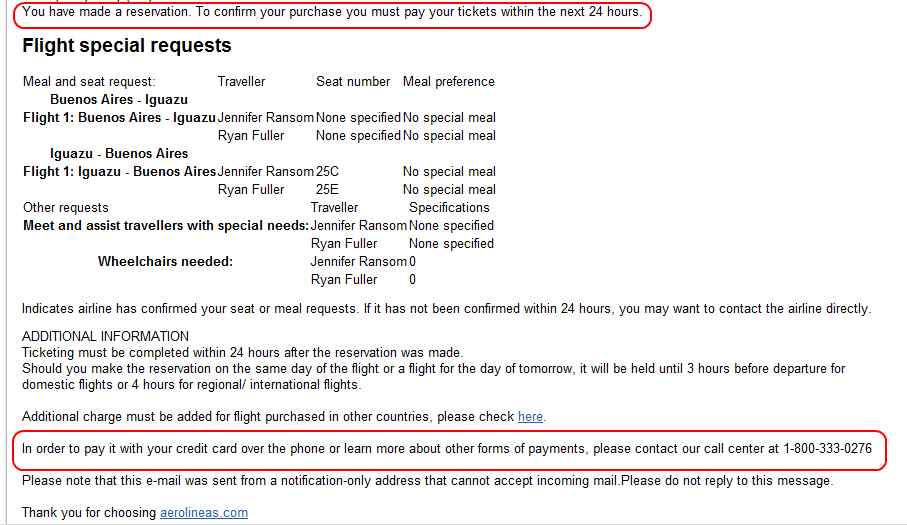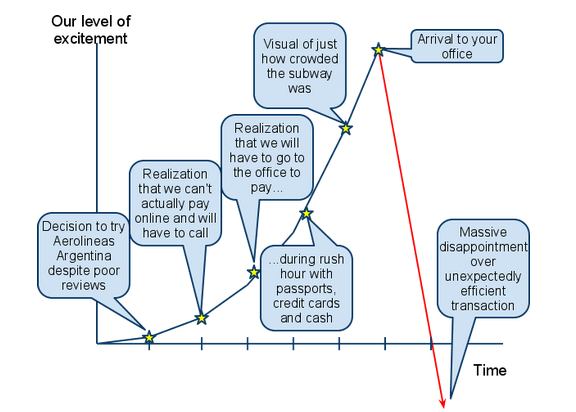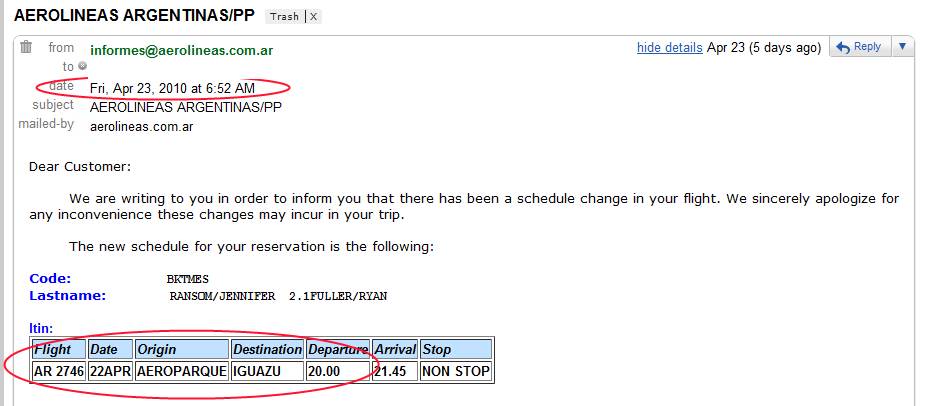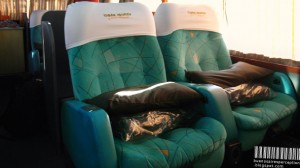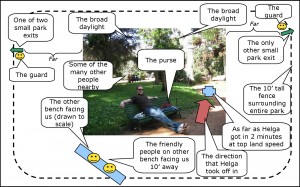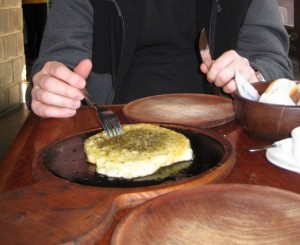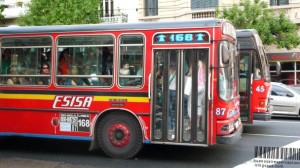Dear Aerolineas Argentina,
You let us down.
I’m writing to express my extreme disappointment that our ticket purchasing experience was so anticlimactic. You may think that we had unreasonably high expectations, but I think you’d have to admit that it was you that raised our expectations by leading us on so tantalizingly in the early stages of the process.
We began shopping for a ticket on your website with a few mild concerns based on having read poor reviews from other travellers, but we were willing to look past those reviews and give you a chance–especially since you were ~$200 cheaper than LAN for our flights to Iguazu. We found a schedule that worked for us and proceeded to make the reservation through your website. Up until then, we thought of you as just another airline and assumed that buying tickets from you would be just like so many other online tickets we’ve purchased before. That was when you first began to tease us…
It seemed strange that we received a confirmation page including seat assignments without ever having been asked to pay for the tickets. We did notice the small print near the bottom that said that we were required to pay within 24 hours and would receive instructions for how to do so in an email. This seemed odd, but we were willing to go with it. However, the email you sent us said this:
We weren’t so excited about calling you to ask how to pay, so instead we did some searching around your website and encountered several sets of instructions clearly indicating that we could and should pay online; however, there was nowhere on your website that actually allowed us to do so.

These instructions are really thorough and helpful... though, if one were being picky, one could argue that if you are going to write detailed instructions, it may be better if the feature actually existed. Sorry if this is culturally insensitive.
Google, TripAdvisor and the local expat blog also seemed to be at a loss for how to proceed. This is when our expectations started to go up–it seemed clear that this was going to be far more exciting than just another ticket purchasing experience. We decided to wait until the next day and ask around at our school to see if any of the locals had encountered this before and were told that despite what your website says, foreigners are in fact required to pay by telephone. We were told that that this has something to do with security to minimize potential for chargebacks (see handy diagram below); but since that clearly doesn’t make any sense at all, my guess is that you just want to have the opportunity to speak live to those of us that are lucky enough to pay at least double your normal prices to thank us (for those of you keeping score at home, it is true that there is massively different price for locals vs. Foriegners)…
Before we called, we only expected to be on hold for awhile and then go through the annoying hassle of giving you all of our credit card info over the phone with a language barrier and nothing more (which obviously we were pretty excited about), but we had no idea what you had in store for us… I can’t convey to you in words how flattered and excited we were when you told us that because the flights were within 48 hours, we would not be able to pay for them over the phone either, but would instead need to go to one of your local offices and pay in person. It was a nice touch that you offered us the alternative of paying at the airport the day of the flights as long as we got there by 3pm (for a 7:45pm flight)–clearly an attractive option.
In fact, we were so excited that we called one of our local friends and asked if he would be willing to call you back with us on a conference call just to make sure that you weren’t giving us any unnecessary “special” treatment; after reconfirming with our friends help, we spent a few minutes basking in the joy of having the opportunity to meet you in person and then got ready to go. At this point, we had given up predicting what new twists and turns the story would take, but we had no doubts that you would have several more surprises in store for us, so we brought multiple forms of identification, a few different credit cards and a decent amount of cash just in case.
After having read about how frequently people get pick-pocketed in the subway, we were particularly excited to have our passports and other valuables with us for the lengthy ride to the end of the D line smack in the middle of rush hour. Being pressed up against the glass for the majority of the ride while trying to keep our belongings with us served to build the suspense higher and higher.
We were at a fever pitch when we arrived at your office and completely ready to experience Crazy Town, AR. BUT, this is where you let us down on several dimensions:
1) There was not even a line, we walked in and were waved directly over to an agent.
2) The agent immediately understood why we were there and was able to process the transaction in under 2 minutes. She then gave us a receipt that we were supposed to bring over to the cashier for payment, so our hopes went up again…
3) Only to be dashed by a <30 second conversation to make the payment with the cashier.
So, in less than 3 minutes we had paid for our tickets and were all set. There was no chaos, there was no demanding of 4+ forms of ID (or any ID at all ironically), there were no language barriers, no 2 hour waits, nothing. You built up these huge expectations for us and then just ruined it all by suddenly being efficient.
You can imagine our disappointment. If for some reason you can not imagine our disappointment, please refer to the diagram below:
Hopefully you can provide us with a more consistent experience next time.
Regretfully yours,
Ryan and Jen
P.S. After thinking through all of our experiences with you thus far, I think I may have figured out how you operate. While many businesses strive to meet or exceed customer expectations, from the 5 examples below, it seems that your customer strategy is simply to do the opposite of what customers expect in every situation. As a former strategy consultant, I for one applaud this boldly differentiated approach to making sure your customers never get bored with you.
Example 1: Trying to purchase ticket online
Our expectation: Just put in credit card info and make purchase
Aerolineas Argentina: State frequently on your site that it is possible to pay online, but instead make it impossible to pay online.
Example 2: Calling to purchase ticket
Our expectation: A mild hassle, but at least we can finalize the purchase
Aerolineas Argentina: Tell us that we have to go to the office to make the purchase
Example 3: Going to office to finalize purchase
Our expectation: A major hassle with low probability of success
Aerolineas Argentina: Super smooth and efficient process
Example 4: Rationale for making us go to the office in person within 48 hours of flight
Our expectation: Something to do with a higher degree of security?
Aerolineas Argentina: Did not check our ID or even look to see if our signature matched the credit card we used
Example: Onboard flight to Iguazu
Our expectation: We may be late, but we’ll get to Iguazu
Aerolineas Argentina: Instead, land in a different city (Posadas) and don’t tell us until we land
P.P.S After reviewing the schedule change email you sent us the day after our flight left, I am further convinced of the above

